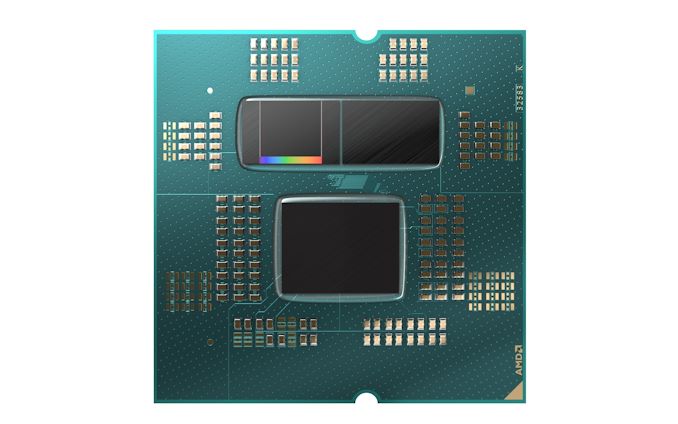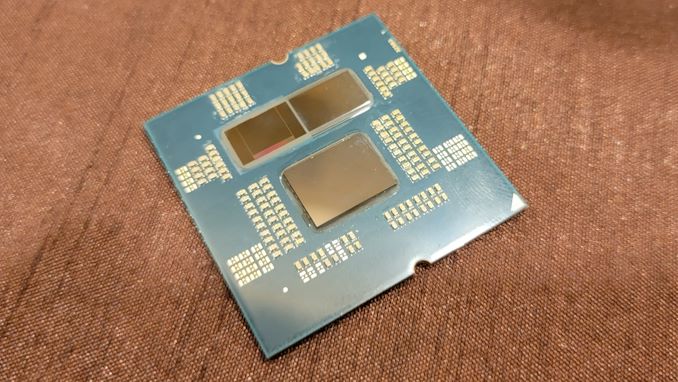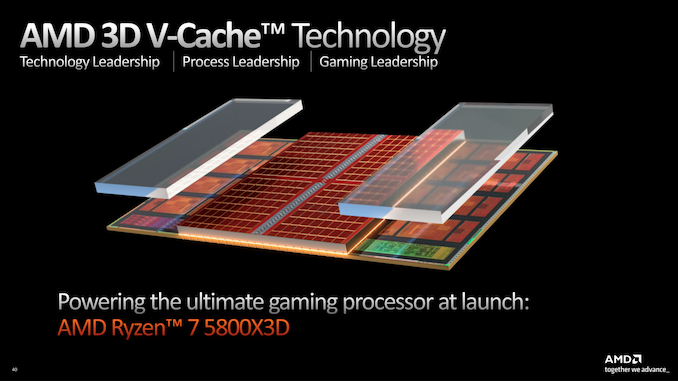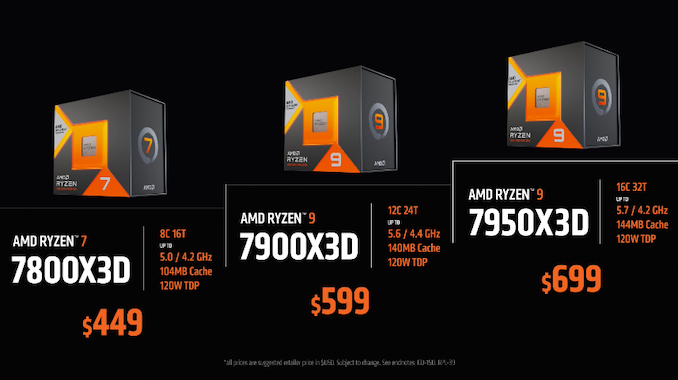AMD’s Ryzen 7000X3D Chips Get Release Dates: February 28th and April 6th, For $699/$599/$449
by Ryan Smith on February 1, 2023 9:45 PM EST- Posted in
- CPUs
- AMD
- X3D
- Ryzen 7000
- Raphael
- 3D V-Cache

AMD today has announced the launch date and prices for its eagerly anticipated Ryzen 7000X3D series processors. Aimed primarily at gamers, the company’s first L3 V-Cache equipped Ryzen 7000 processors will begin rolling out on February 28th, when the Ryzen 9 7950X3D and Ryzen 9 7900X3D go on sale for $699 and $599 respectively. This will be followed up by the Ryzen 7 7800X3D a bit over a month later, when it goes on sale for $449 on April 6th.
First announced to great fanfare during AMD’s CES 2023 keynote (and teased well before that), the Ryzen 7000X3D chips will be AMD’s second generation of consumer chips employing the company’s novel 3D stacked V-Cache technology. V-Cache allows AMD to stack a 64MB L3 cache die on top of their existing CCDs in order to expand the total L3 capacity of a Zen 3/4 CCD, going from 32MB to 96MB. And in the case of multi-CCD designs such as the Ryzen 9 7950X, bringing the total, chip-wide L3 cache pool to 128MB.
| AMD Ryzen 7000X/X3D Series Line-Up | |||||||
| AnandTech | Cores Threads |
Base Freq |
Turbo Freq |
L3 Cache |
TDP | Price (Street) |
Release Date |
| Ryzen 9 7950X3D | 16C / 32T | 4.2 GHz | 5.7 GHz | 128 MB | 120W | $699 | 02/28/23 |
| Ryzen 9 7950X | 16C / 32T | 4.5 GHz | 5.7 GHz | 64 MB | 170W | $583 | - |
| Ryzen 9 7900X3D | 12C / 24T | 4.4 GHz | 5.6 GHz | 128 MB | 120W | $599 | 02/28/23 |
| Ryzen 9 7900X | 12C / 24T | 4.7 GHz | 5.6 GHz | 64 MB | 170W | $444 | - |
| Ryzen 7 7800X3D | 8C / 16T | 4.2 GHz | 5.0 GHz | 96 MB | 120W | $449 | 04/06/23 |
| Ryzen 7 7700X | 8C / 16T | 4.5 GHz | 5.4 GHz | 32 MB | 105W | $299 | - |
| Ryzen 7 5800X3D | 8C / 16T | 3.4 GHz | 4.5 GHz | 96 MB | 105W | $323 | - |
Following the successful trial of the technology in the consumer space with AMD’s original Ryzen 7 5800X3D, which was released to positive acclaim back in the spring of 2022, AMD has developed a much broader lineup of V-Cache equipped Ryzen chips for this generation. This includes not only the 5800X3D’s direct successor, the 8 core Ryzen 7 7800X3D, but also, for the first time, chips employing multiple CCDs. These are the Ryzen 9 7900X3D and 7950X3D, which will offer 12 and 16 CPU cores, respectively.
Interestingly, AMD has gone for a non-homogenous design for these multi-CCD parts – rather than giving both CCDs V-Cache, AMD is only outfitting one of the CCDs with the extra L3 cache. The other CCD will remain a plain Zen 4 CCD, with its integrated 32MB of L3 cache. The unbalanced design, besides allowing AMD to control the costs of what’s still a relatively expensive technology to implement, will allow AMD to offer something close to the best of both worlds for their multi-CCD parts. The V-Cache equipped Zen 4 CCDs will offer 6 or 8 CPU cores backed by the massive L3 pool, for tasks that benefit from the larger cache size, while the vanilla Zen 4 CCDs will be unencumbered by the V-Cache, allowing them to clock higher for pure throughput workloads that wouldn’t benefit from the extra cache.
As with the original 5800X3D, AMD is aiming these chips at gamers in particular, as the complex, heavy-dataset nature of video games means they often benefit from having additional L3 cache on-hand. The 5800X3D was, depending on the game, around 15% faster than its vanilla Ryzen counterpart – at least so long as it wasn’t GPU limited. AMD is being a bit more coy this time around on making apples-to-apples comparisons against their regular Ryzen 7000 chips, so for now the only official performance figures available from AMD are pitting the chips against the 5800X3D. In lieu of that, a 15% improvement is a reasonable baseline given that the cache sizes haven’t changed in the last generation, but we’ll definitely want to take a closer look at the final chips to see if the additional L3 cache is as beneficial to Zen 4 as it was for Zen 3.
Back at their CES 2023 keynote, AMD announced the specifications for two-and-a-half of the chips, as well as an undetailed February launch date. With today’s announcement, AMD is finally filling in the rest of the details, as well as confirming that only part of the product stack is going to make that February launch date.

(Image Courtesy Tom's Hardware)
As previously noted, the Ryzen 9 7950X3D and Ryzen 9 7900X3D both launch on February 28th. The 16 core 7950X3D will hit the streets with a $699 price tag, while the 12 core 7900X3D will intro at $599. At current street prices, this represents roughly a $100 to $150 premium over the chips’ regular counterparts, with the 7950X selling for around $583, and the 7900X selling for around $444. Prices on AMD’s top AM5 chips have come down a decent bit since their 2022 launch, so the new X3D SKUs are coming in at similar launch prices as their non V-Cache counterparts. Put another way, whereas $699 would get you a 16 core 7950X in September, come February it will get you the same chip with an additional 64MB of L3 cache.
Other than benchmarks, at this point the only detail we don’t have on the 7950X3D and 7900X3D are the clockspeeds for the V-Cache equipped CCDs. AMD’s quoted turbo clockspeeds are for the vanilla CCD, so it’s unclear just how much clockspeeds have been lowered for the V-Cache CCD. But taking a hint from AMD’s sole single CCD X3D part, the 7800X3D, we see that part has a top clockspeed of just 5.0GHz. So we’d expect something similar for the V-Cache CCDs on the Ryzen 9 parts.
Speaking of the Ryzen 7 7800X3D, we finally have the full specifications on AMD’s most straightforward X3D part. Back in January AMD hadn’t locked down the base clockspeeds on this part, but as of today we finally have the answer: 4.2GHz. The chip will, in turn, be able to turbo as high as 5.0GHz as previously noted.
The cheapest of the Z3D parts, with a price tag of $449, the 7800X3D will also be the laggard of the group, with the chip not launching until April 6th. AMD has not explained the gap in launch dates, but it’s reasonable to assume that AMD is prioritizing the assembly and shipping of their more expensive Ryzen 9 SKUs. In any case, at current street prices the 7800X3D will carry a $150 premium over the $299 7700X, making it a full 50% more expensive, assuming these street prices hold through April. This happens to be the same price the 5800X3D launched at, so AMD is technically just holding the line here, but it does underscore how price cuts on the rest of the Ryzen 7000 lineup have made the standard chips very competitive on a price/performance basis.
In any case, we’ll have more on AMD’s first V-Cache equipped Zen 4 chips later this month. Besides taking an in-depth look at the performance improvements brought about by the larger L3 cache, the other major factor driving performance is going to be the Windows thread scheduler. As this is AMD’s first asymmetric Ryzen CPU, it will be up to Windows and AMD’s chipset driver to figure out which CCD to place threads on for the 7950X3D/7900X3D. So this month’s launch is going to require that AMD’s hardware and software offerings are in sync in order for the company to make a good first impression.












64 Comments
View All Comments
Bruzzone - Tuesday, February 7, 2023 - link
According to Kevin Krewell ccd to ccd and to i/o on an off fabric connects through Serdes its not a direct bus yet. mbgodrilla - Wednesday, February 1, 2023 - link
Gaming performance is probably the same hence why they wanted to space the cheaper 7800x3d cpu in the end of April. Also if the 7900x3d has a 6 core chiplet with 3d cache does that mean a 7600x3d is possible? Or is it a 8 core 3d chiplet with 4 core chiplet for second chiplet making a 4 core part for Zen 4 possible as well.brucethemoose - Wednesday, February 1, 2023 - link
Thats a very interesting question, as it would definitely affect scheduling.I would probably buy a 7600X3D myself. I am dying for ST performance (not just for simulation games, but for Python and some other niches), and most anything I need more than 6 threads for has either moved to GPUs, is not time sensitive or would be "good enough" on a 7600X3D.
Cooe - Thursday, February 2, 2023 - link
3D V Cache doesn't improve single-core performance (unless that single thread manages to be cache/memory bound)... In fact, for a single CCD part it actually makes it WORSE because of the lower clocks!And plenty of things still want CPU threads, which is increasingly including current gen games. With the current gen consoles having straight up 8c/16t Zen 2 Mobile CPU's in them (aka, basically pulled right outta Renoir/Ryzen Mobile 4000), more and MORE games are able to utilize a full 8-core CPU! If you play modern games AT ALL you are setting yourself up for massive failure later in this console generation if you only get a 6c/12t CPU and don't plan on upgrading it anytime in the next couple of years. 🤷
(This is EXACTLY analogous to how 4c/4t i5's were PLENTY for most of the last console generation until the very last couple of years where all 8x wimpy CPU threads on the PS4/XBO were being COMPLETELY TAPPED by developers, causing SIGNIFICANT performance gaps in-between the 4c/4t i5's and the full-fat & also 8x thread 4x/8t i7's.)
brucethemoose - Thursday, February 2, 2023 - link
This is untrue for me, the simulation-heavy games I play are bound to one or a few threads and respond very well to VCache.The few AAAs I play are fine on older CPUs.
I am less sure about python stuff (where the bottleneck shows up in little bursts where the GPU isnt working). But I think VCache should be kind to JIT languages as well.
lmcd - Friday, February 3, 2023 - link
This isn't a good summary of the scenario because the PS4/XBO CPU problem only happened out of desperation due to the abysmal IPC on each PS4/XBO core. On games that drop XBO/PS4, they can revert to primarily loading up a few threads heavily, which results in less total work (as synchronizing workloads that were not meant to be split across threads ends up increasing the total amount of work).Zen 2 can bottleneck the XSX and PS5 GPUs, but not proportionately as much. There are way more optimizations to exploit that will prevent overloading all 8 cores, and in a situation where 4 of the 8 threads are truly loaded up, a 6c12t part that is already substantially ahead of the 8c16t part in IPC will be absolutely fine.
The bigger concern is memory bandwidth, which is what the V-Cache solves. If anything, I think parts that don't have V-Cache will get shredded once games start truly taking advantage of direct GDDR access from the CPU (remember, Xbox One OG/S had DDR3 and a 32MB cache, which did very little to solve the DDR3 problem).
nandnandnand - Thursday, February 2, 2023 - link
I don't think AMD is required to do 8+4 due to a limitation of how the cache works, so a 7600X3D should be possible. But if they want to keep X3D premium, they won't make one. It would be interesting if the 7900X3D was 8+4, but I expect 6+6.4-cores are obviously possible, just unlikely because of chiplets and yields. AMD will even disable 6-7 cores in some cases. Like the Ryzen 3 5125C with only 2 of 8 cores (monolithic die), or the EPYC 72F3 with only 1 core enabled per chiplet. There is already a Zen 4 chip that enables 4 cores on each chiplet: the EPYC 9374F.
Silver5urfer - Friday, February 3, 2023 - link
AMD will never release a 7600X3D processor, that will eat all Gaming sales for these Zen 4 lineup. Plus binning a 6C CCD on a X3D stack is not easy because you already have defect silicon with 2C disabled. And these X3D are high voltage unlike the Zen 3 X3D which are low voltage.Bruzzone - Tuesday, February 7, 2023 - link
7600X3D is possible It's retail would be $368 down to $276 run end clearance but on more cache per core I agree on the octa cannibalization question. I also question whether hexa ccd can be used on bonding pad placement. mbZoolook - Saturday, February 4, 2023 - link
Considering that the boost clock is much lower on the 7800X3D than the 7700X, I'd say it's one CCD.